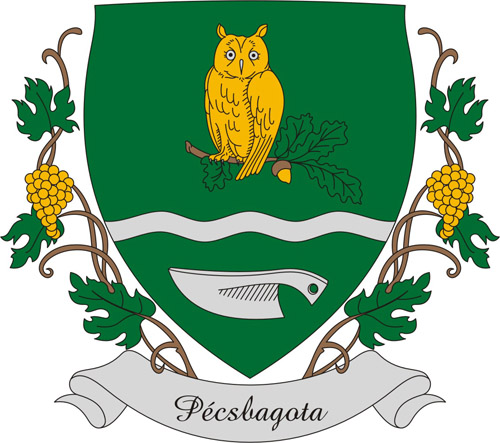
(Baranya megye)
Klasszikus ívelésű doborpajzs, ezüst hullám-pólyával vágva.
A pajzsfő zöld mezejében tölgyfaágon ülő természetes színű bagoly „lebeg”.
A pajzstalp zöld mezejében lebegő ezüst ekevas található.
A címerpajzs alatt ezüst szalag – Pécsbagota felirattal – helyezkedik el.
A szalagból a pajzsot balról és jobbról övező természetes színű szőlőinda (3-3 levéllel és 1-1 arany szőlőfürttel) „nő ki”.
Pécsgabota címere heraldikai szempontból szabadosnak mondható, melyben a szimbólumrendszer egysége és harmóniája, továbbá a település múltjával összhangban álló tradíció egyaránt kifejezésre jut.
A címer központi motívumai a település név-etimológiájával, illetve a település hagyományaival hozhatók kapcsolatba.
A bagoly - viszonylag ritka - ábrázolása a tölgyfaággal, a címer megkülönböztető jellegén túl, utal a hajdani település erdőben, vadban gazdag voltára, akárcsak a pajzsot övező inda a helység szőlő- és borkultúrájára.
(The County of Baranya)
Spade shield of classical shape, party per fess with a wavy bend argent.
In chief vert an oak branch with an own sitting on it. The charge is borne encouped and tinctured proper. In base vert a ploughshare argent is borne encouped,
Below the shield a ribbon argent with the settlement’s name PÉCSBAGOTA inscribed in it. From ribbon a wine tendril is issuing ont he dexter and ont he sinister side. It is tinctured proper. The charge of the wine tendril is decorated with 3 leaves and one bunch of grapes, or on each side.
From a heraldic point of view the coat of arms of the village of Pécsbagota is characterised by the unity and harmony of its charges, and theri relatedness to the settlement’s past and traditions.
The central charges of the settlement’s coat of arms refer to the etymology of the village’s name as well as to its traditions.
The owl is a relatively rare heraldic charge. The bird and the oak branch make the settlement’s coat of arms very uniquem and, in addition, they refer to the settlement’s richness in game. The wine leaves and tendrils as well as the bunches of grapes in the settlement’s coat of arms symbolise local viniculture.